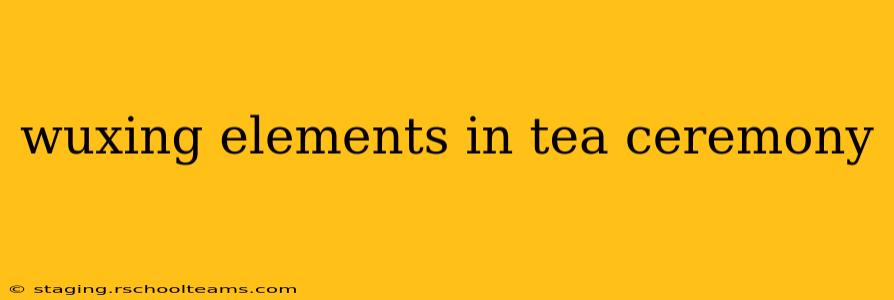The Chinese tea ceremony, or Cha Dao (茶道), is far more than just the preparation and consumption of tea. It's a deeply spiritual and philosophical practice rooted in centuries of tradition, encompassing elements of mindfulness, aesthetics, and harmony. Central to this philosophy is the integration of the Wu Xing (五行), or Five Elements – Wood, Fire, Earth, Metal, and Water – which represent fundamental forces of nature and influence all aspects of life. Understanding how these elements intertwine within the tea ceremony enhances the experience and reveals a deeper appreciation for its intricacies.
How are the Five Elements Represented in the Tea Ceremony?
The Wu Xing's influence permeates the tea ceremony subtly but profoundly. It's not about blatant displays but rather a harmonious balance achieved through mindful selection and execution:
Wood (木): Growth and Spring
- Representation: The budding leaves of the tea plant itself are a prime example of Wood. The process of growth, from tiny bud to mature leaf, mirrors the element's essence. The elegant lines of the teaware, particularly bamboo utensils, also embody the upward-reaching energy of Wood.
- In Practice: The careful preparation of the tea leaves, nurturing them to unlock their full potential, reflects this element. Selecting young, vibrant leaves, essential to a high-quality brew, symbolizes the vitality of Wood.
Fire (火): Transformation and Summer
- Representation: The act of heating the water, the process of steeping the tea leaves, and the transformation from leaf to liquid all represent Fire. The warm color of the tea itself and the warmth shared amongst participants also embody this element. The vibrant red hues of some teaware also resonate with Fire.
- In Practice: The precise control of water temperature, a critical aspect of tea brewing, showcases the transformative power of Fire. The controlled application of heat, neither too intense nor too weak, is crucial for extracting the optimal flavor and aroma.
Earth (土): Nourishment and Late Summer
- Representation: The earth provides the nourishment for the tea plant to grow. The tea ceremony table, the grounding presence of the setting, and the earthenware teacups all represent the element of Earth. The rich, earthy aromas of some teas also reflect this connection.
- In Practice: The meticulous preparation and presentation of the tea, a careful nurturing of the elements, reflects Earth's nurturing nature. The tea itself acts as a nourishing substance for body and mind.
Metal (金): Clarity and Autumn
- Representation: The metal teapot, often crafted with precision, symbolizes the element of Metal. The gleaming surfaces of refined metal teaware capture and reflect light, signifying clarity and precision. The clean, crisp taste of some teas also echoes Metal’s sharpness.
- In Practice: The precise movements of the tea master, the clean lines of the ceremony, and the focus on detail all reflect the element of Metal’s refined precision. The clear, sharp tasting notes of the tea itself can also embody this element.
Water (水): Flow and Winter
- Representation: Water is essential for brewing tea. Its fluidity and adaptability are central to the ceremony. The smooth, flowing movements of the tea master also echo this element. The cool temperature of certain teas (especially served in winter) reflects Water's gentle energy.
- In Practice: The smooth, flowing movement of the ceremony, the gentle pouring of the tea, and the careful consideration of the water temperature all showcase the fluidity and adaptability of Water.
Frequently Asked Questions
What is the significance of using specific teaware in a tea ceremony?
The choice of teaware is integral to the Wu Xing balance. Different materials (clay, metal, bamboo) and forms resonate with various elements, creating a harmonious environment that complements the tea and experience. This is not arbitrary; it adds another layer of intentionality to the ritual.
How does the Wu Xing affect the taste and aroma of the tea?
While not directly altering the tea's inherent properties, the Wu Xing principles influence how the tea is prepared and appreciated. By balancing the elements during preparation, the tea master can unlock the full potential of the tea's aroma and flavor profile, leading to a more complete and enjoyable experience.
Is it necessary to understand the Wu Xing to appreciate the tea ceremony?
No, it’s not necessary to deeply understand the Wu Xing to appreciate the tea ceremony. The beauty and mindfulness of the process are accessible to all. However, understanding the underlying philosophy adds depth and enriches the experience, revealing hidden layers of meaning and intention within the ritual.
Can I apply the Wu Xing principles to my own tea brewing at home?
Absolutely! Even a simple home tea preparation can benefit from mindful consideration of the Wu Xing. Consider the materials you use, the temperature of the water, and the environment you create to foster a sense of balance and harmony.
By understanding and appreciating the Wu Xing elements within the tea ceremony, we move beyond a simple act of drinking tea and enter a world of mindful practice, aesthetic appreciation, and profound connection to nature. It’s a journey of harmony and balance, mirroring the natural world and enriching our inner lives.
